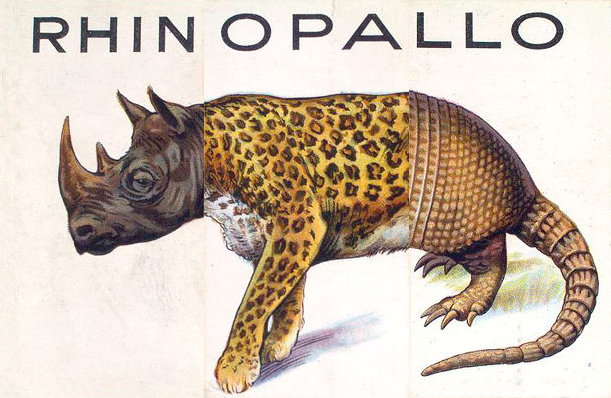In the 1930s a British tobacco company, the W.D. and H.O. Willis Company issues a series of illustrated animal cards, that comprised a kind of matching game. Each card contained a portion of an illustration of an animal, a rhino, leopard, or platypus, etc. The cards could be 'matched' to assemble the correct entire animal, or, more interestingly, be combined to discover new creations like in the image at right.
animal, or, more interestingly, be combined to discover new creations like in the image at right.
From the official instructions on the cards:
The complete series comprises 16 animals, each in three sections, and by mixing the sections you can produce a large number of strange creatures with amusing names.
It is natural when playing this kind of game to want to build the 'correct' creature, to align the front, middle, and back of the armadillo or the alligator - to get the 'right' answer.
But it is much more interesting to mix up the cards to build something new and unique and totally original. And likely much more exciting and scary than the 'right' animal.
I think that analogy carries over to what can happen in the organization as well. We create, as a matter of tradition and I suppose necessity, roles and job descriptions like 'programmer', 'analyst', 'recruiter', that are the functional equivalent of the 'right' animal in the card game. But the problem is that most people, likely the most talented and interesting people, don't really fit those roles and descriptions, at least not totally. Like in the card game, they are maybe one third a 'programmer' and one third an artist, and maybe one third a community leader. Or a combination of accountant, bowler, and glee club singer.
While I don't think organizations can or should attempt to create that try to formalize these odd combinations of traits or characteristics, at least perhaps some more awareness of and recognition of the diversity, complexity, and 'interestingness' of the people that comprise the organization's talent pool would be beneficial.
What could some of the benefits be? Perhaps to better tap internal talent for new ideas and innovations, to gain increased knowledge of some of the drivers effecting workplace health and wellness, to find or discover ideas and opportunities for enhanced community outreach and volunteerism, and even possibly to unearth new marketing and business development opportunities in underserved market segments. Heck, maybe just to make the office a little more 'fun'.
The truth is all organizations are made up of 'strange creatures with amusing names', and mostly we try to fit them into classifications and roles that are better described as 'mundane creatures with common names'.
What seems more interesting to you?
You can 'play' the animal matching game online - here.
